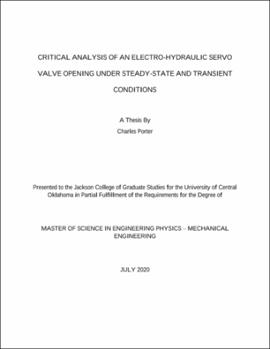| dc.description.abstract | Electro-Hydraulic servo valves (EHSV) are used extensively in industrial applications due to their lightweight design, inexpensive manufacturing, simple operating technology, and modularity. EHSV are used in military, industrial, aviation, and other applications. The engineering design, testing and prototyping of EHSV as implemented in a given fluid system can be expensive and time consuming. Improvements made in computational modeling and simulation of system designs that include EHSV can reduce time and cost in implementing EHSV in fluid systems by leveraging computational capabilities to predict performance of EHSV. The operating principles and flow effects of EHSV used in industry are often difficult to predict in a particular fluid system. Simulation of EHSV has the potential to improve prediction of performance in given systems, but the challenge is that simulating flow in EHSV can be very challenging due to transient (TR) flow and dynamic geometries. This thesis focuses on simulating fluid flow at various times as an EHSV is opening to determine flow parameters for a specific industrial EHSV design utilizing steady-state (SS) and TR modeling. Consistency between SS and TR techniques is calculated. Data from a similar experimental system is compared to determine simulation accuracy and evaluate modeling effectiveness of SS and TR techniques. The standard k-ε method for modeling turbulence in the system was utilized to simulate a valve opening under both SS and TR conditions. In the TR simulation dynamic meshing was utilized for the region where the mesh moves model valve opening. Simulation results show similarities in flow profiles and parameters between SS and TR models. Dynamic meshing near the valve opening, when the valve just begins to open, induces error throughout the system and effects all flow field parameters studied in this thesis. The SS and TR models each have an area where their accuracy is optimum. Steady-state modeling provides better accuracy where dynamic meshing may induce error for small geometries and gaps, while dynamic TR modeling is more accurate for larger less complicated mesh structures. The SS simulation averaged a 7.96% difference from the experimental values over the range of 1.95mm ≥XL ≥4.17mm, where XL is the distance a control spool has moved to open the valve, while the TR simulation averaged 7.81% difference. The difference in accuracy between the two different type of models would be negligible in most applications for valve design. The TR simulation averaged an 7.86% difference from the experimental values over the range of 4.17 mm ≥ XL ≥ 7.87 mm, while the SS simulation averaged 17.52% accuracy over that same range. A difference of approximately 9.66% may be significant enough to effect design. These values provide insight into simplifying simulated models for applications where accuracy reduction is an acceptable trade-off for time and computational expense related to performing more complicated and difficult models such as a dynamic and transient model. Further research may be conducted into simplifying models and simulation for industry design applications. | en_US |
